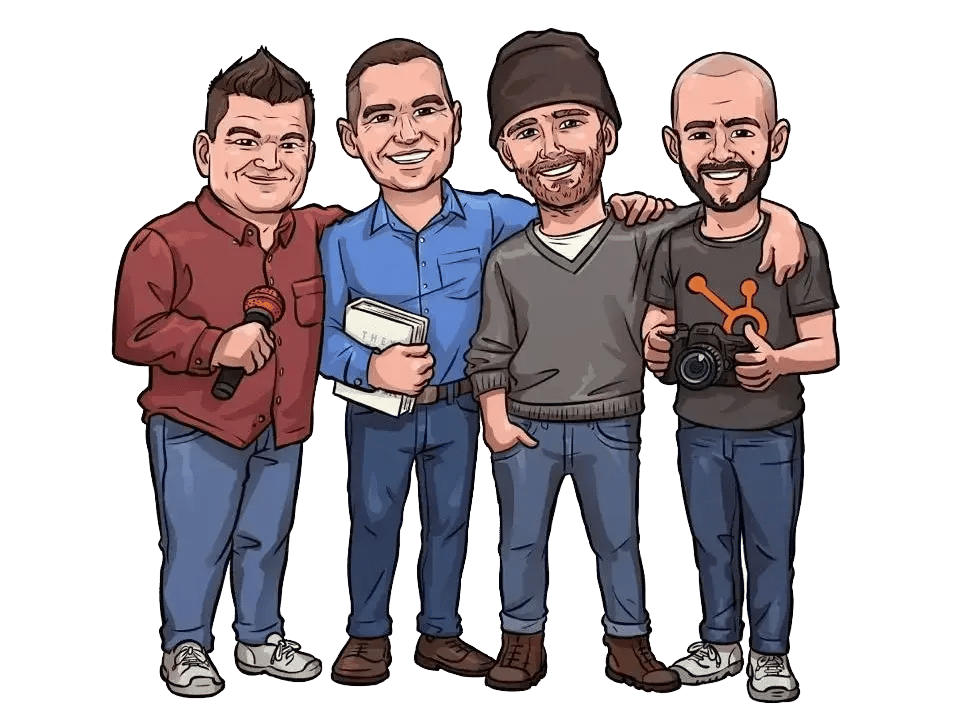5 min read
How They Ask, You Answer Became the Blueprint for AEO in 2025
 George B. Thomas
Sep 8, 2025 12:30:48 PM
George B. Thomas
Sep 8, 2025 12:30:48 PM
Rather listen to this post?
Let me take you back. Before there was a book called They Ask, You Answer, there was a pool company in Virginia called River Pools and Spas. Marcus Sheridan, the co-owner, decided to do something radical at the time. Instead of hiding behind marketing gloss, he answered every single question customers asked.
-
How much does it cost?
-
What are the problems with fiberglass pools?
-
How does fiberglass compare to concrete or vinyl?
Marcus wrote the answers down. He put them on the website. And then something wild happened. Leads went up. Sales went up. Trust skyrocketed.
That experiment turned River Pools into a national case study and put Marcus on stages around the world, teaching other businesses to do the same.
From that success, Marcus launched The Sales Lion, a digital sales and marketing agency dedicated to helping companies embrace this new philosophy of radical honesty in their content. By the time I joined The Sales Lion, Marcus was already speaking globally and teaching strategy everywhere.
My role was clear: while Marcus taught content strategy, I would teach HubSpot, the technology that powered it all. We worked remotely. Marcus is in Virginia. I'm in North Carolina. And somewhere in those years, Marcus asked another bold question: What if there were a podcast just for HubSpot users?
His idea, and me, well I came kicking and screaming. (I hated my voice back then.) But it became one of my biggest strengths over the years. That's how The Hubcast was born. The first HubSpot-specific podcast. Every week we unpacked updates, inbound plays, and the philosophy of answering questions with courage.
Looking back, those early episodes weren't just news. They were us practicing They Ask, You Answer in real time, showing how content and technology come together.
Why They Ask, You Answer Still Wins
The idea is timeless. If your customers ask it, you answer it. No fluff. No gimmicks. Just real answers.
And the beating heart of the strategy is what Marcus called The Big Five:
-
Pricing and cost: what it really takes to invest.
-
Problems and drawbacks: the good, the bad, and the ugly.
-
Comparisons: side-by-side clarity buyers crave.
-
Reviews and proof: what others actually say.
-
Best in class lists: the roundup everyone Googles before deciding.
You become the trusted teacher in your space when you consistently answer those questions with honesty. That was true in the River Pools days. It was true when we built The Sales Lion.
And it's still true now.
Most strategies get washed away by technology shifts. Algorithms change. Platforms fade. But They Ask, You Answer keeps working because it isn't built on tech tricks. It's built on trust.
Search Has Shifted: From Results to Answers
When we started, the prize was getting on page one of Google. Ten blue links, and the click battle was on.
But today? Humans don't just type keywords. They ask full-blown questions to AI-powered tools like ChatGPT, Google Gemini, Claud, Perplexity, Siri, or Alexa. And instead of links, they get direct answers.
Welcome to Answer Engine Optimization (AEO). AEO is about structuring your content to be the answer these AI platforms select and deliver. The funny thing? If you've been practicing They Ask, You Answer, you're already on the right path. The very things that make content trustworthy to humans, clarity, honesty, structure, make it irresistible to AI too.
My INBOUND 2025 Epiphany
I was sitting in the audience at INBOUND when HubSpot's CEO, Yamini Rangan, said four words that hit me like a thunderclap:
"Be part of the answer."
I almost laughed out loud. Because that's what we'd been doing since the River Pools days, the Sales Lion era, and those Hubcast nights. In that moment, I realized They Ask, You Answer had officially matured. It wasn't just a content philosophy anymore. It was a full SEO + AEO strategy.
SEO was about ranking. AEO is about being the response itself.
When Yamini spoke, it was like someone had finally put a new name on what we'd been building toward all along.
The Big Five in 2025: How to Optimize for Humans and AI
Let's make it practical. Here's how to adapt each of the Big Five for today's world of search engines and answer engines.
Pricing and Cost
For humans: Be transparent. Share ranges, factors that affect price, and context that explains value. Even if you can't post an exact number, guide buyers with clarity.
For AI: Use question-style headings like "How much does X cost?" and answer directly in one short sentence before diving deeper. Add bullet-point breakdowns AI can easily lift.
Problems and Drawbacks
For humans: Call out the elephants in the room. Share common concerns and where your solution may not be the right fit. Buyers trust brands that don't pretend to be perfect.
For AI: List drawbacks clearly and briefly. Format them as numbered points with quick explanations, so engines can summarize easily.
Comparisons
For humans: Create fair, side-by-side breakdowns. Use tables and end with a simple "who each is best for" guide.
For AI: Include "vs" in titles and headers. Use structured lists or tables so the machine can parse similarities and differences quickly.
Reviews and Proof
For humans: Publish real case studies, detailed testimonials, and curated reviews that show both pros and cons.
For AI: Use schema markup for reviews if possible. Summarize outcomes in a single sentence: "Customers consistently report X benefit, while noting Y as a limitation."
Best-in-Class Lists
For humans: Create numbered lists of the top solutions in your category, with short reviews and clear criteria. Be fair, even if competitors make the cut.
For AI: Put the year in the title, use an ordered list, and keep descriptions short and factual. Update regularly to stay fresh.
How to Audit and Upgrade Your Content for AEO
-
Inventory. Gather every blog post, FAQ, video, or resource you've created. Map each to the question it answers and which Big Five category it fits.
-
Gap Analysis. Identify what's missing. Where are you silent? Pricing, problems, or reviews? Those gaps are opportunities.
-
Optimize.
-
Rewrite titles to mirror the questions humans ask.
-
Lead with the answer in the first line.
-
Break up text with headers and lists.
-
Update data and examples to 2025.
-
Add TLDR summaries and decision guides.
-
This process turns your site into a library of answers that humans trust and AI engines pull from.
A Quick Story of Honest Content Winning
One small marketing agency leaned into this approach. They wrote an article on pricing, created an honest "problems with" guide, and compared their product fairly to two competitors. Within months, prospects said, "I asked ChatGPT about this, and your article came up with the answer."
That's the magic of combining TAYA with AEO.
When you answer with courage, you don't just rank. You become the teacher the AI cites. And when prospects hear your voice before they ever talk to sales, half the trust battle is already won.
Bring It Home
Reflection: Would your content today be read aloud by an AI assistant and make the buyer trust you more? Or would it sound vague, fluffy, or incomplete?
Action: Pick one Big Five category you've ignored. Write the most candid, scannable, and helpful answer in your space within the next two weeks. Lead with the answer. Add a quick table or list.
Publish it. Share it with your sales team.
Ready for a Sidekick?
If you're realizing your content isn't where it needs to be or if your HubSpot isn't set up to support this strategy, we're here to help. At Sidekick Strategies, we live this work. We help companies turn customer questions into cornerstone assets, set up HubSpot so it fuels growth, and coach teams to create content that humans trust and AI promotes.
So, if you need help with content, HubSpot, or just want to start the conversation, let's connect. The future belongs to the brands that are willing to be the answer.


